weight LINCOLN MKZ HYBRID 2013 Owners Manual
[x] Cancel search | Manufacturer: LINCOLN, Model Year: 2013, Model line: MKZ HYBRID, Model: LINCOLN MKZ HYBRID 2013Pages: 475, PDF Size: 3.89 MB
Page 17 of 475
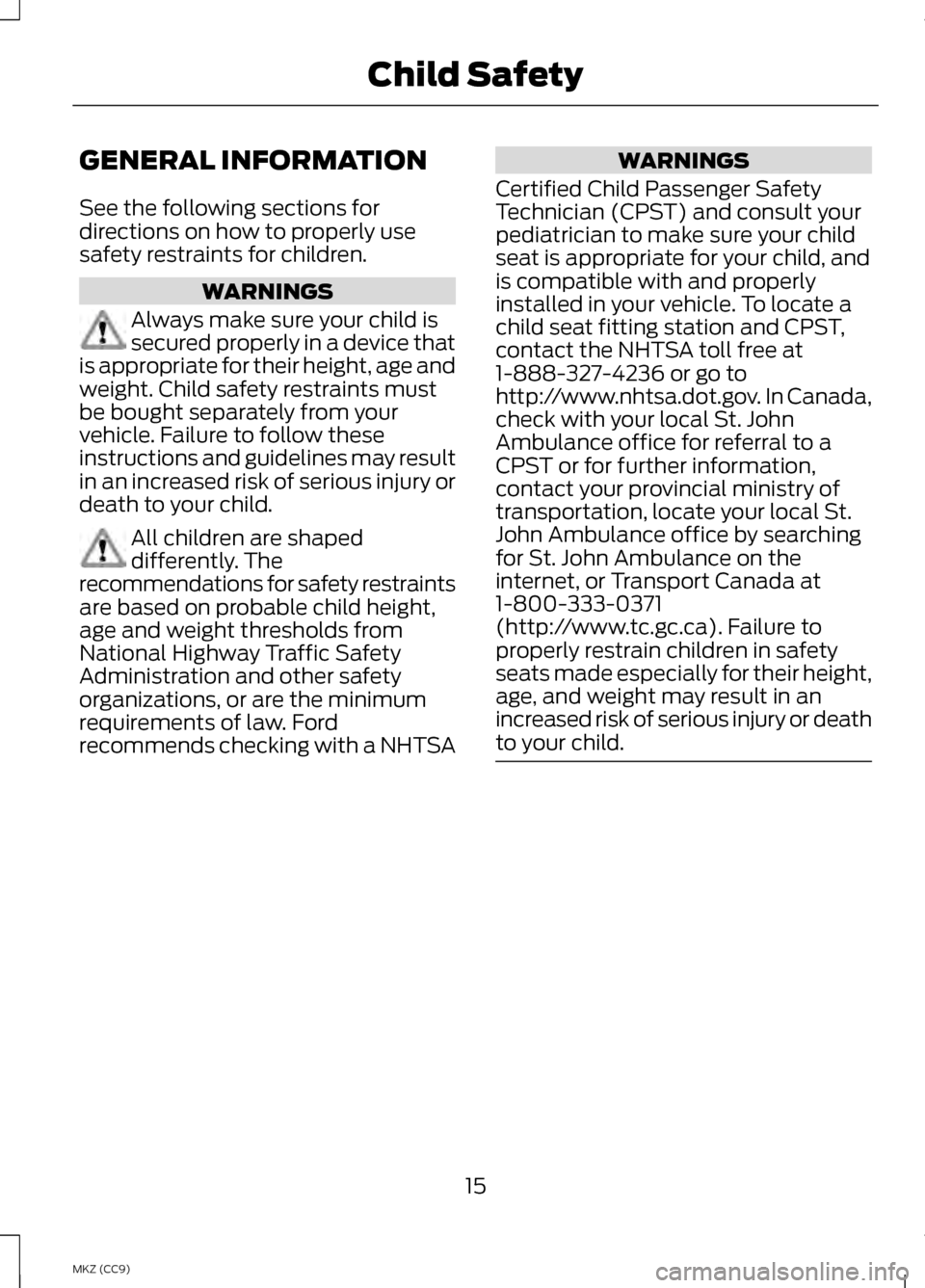
GENERAL INFORMATION
See the following sections for
directions on how to properly use
safety restraints for children.
WARNINGS
Always make sure your child is
secured properly in a device that
is appropriate for their height, age and
weight. Child safety restraints must
be bought separately from your
vehicle. Failure to follow these
instructions and guidelines may result
in an increased risk of serious injury or
death to your child. All children are shaped
differently. The
recommendations for safety restraints
are based on probable child height,
age and weight thresholds from
National Highway Traffic Safety
Administration and other safety
organizations, or are the minimum
requirements of law. Ford
recommends checking with a NHTSA WARNINGS
Certified Child Passenger Safety
Technician (CPST) and consult your
pediatrician to make sure your child
seat is appropriate for your child, and
is compatible with and properly
installed in your vehicle. To locate a
child seat fitting station and CPST,
contact the NHTSA toll free at
1-888-327-4236 or go to
http://www.nhtsa.dot.gov. In Canada,
check with your local St. John
Ambulance office for referral to a
CPST or for further information,
contact your provincial ministry of
transportation, locate your local St.
John Ambulance office by searching
for St. John Ambulance on the
internet, or Transport Canada at
1-800-333-0371
(http://www.tc.gc.ca). Failure to
properly restrain children in safety
seats made especially for their height,
age, and weight may result in an
increased risk of serious injury or death
to your child. 15
MKZ (CC9) Child Safety
Page 18 of 475
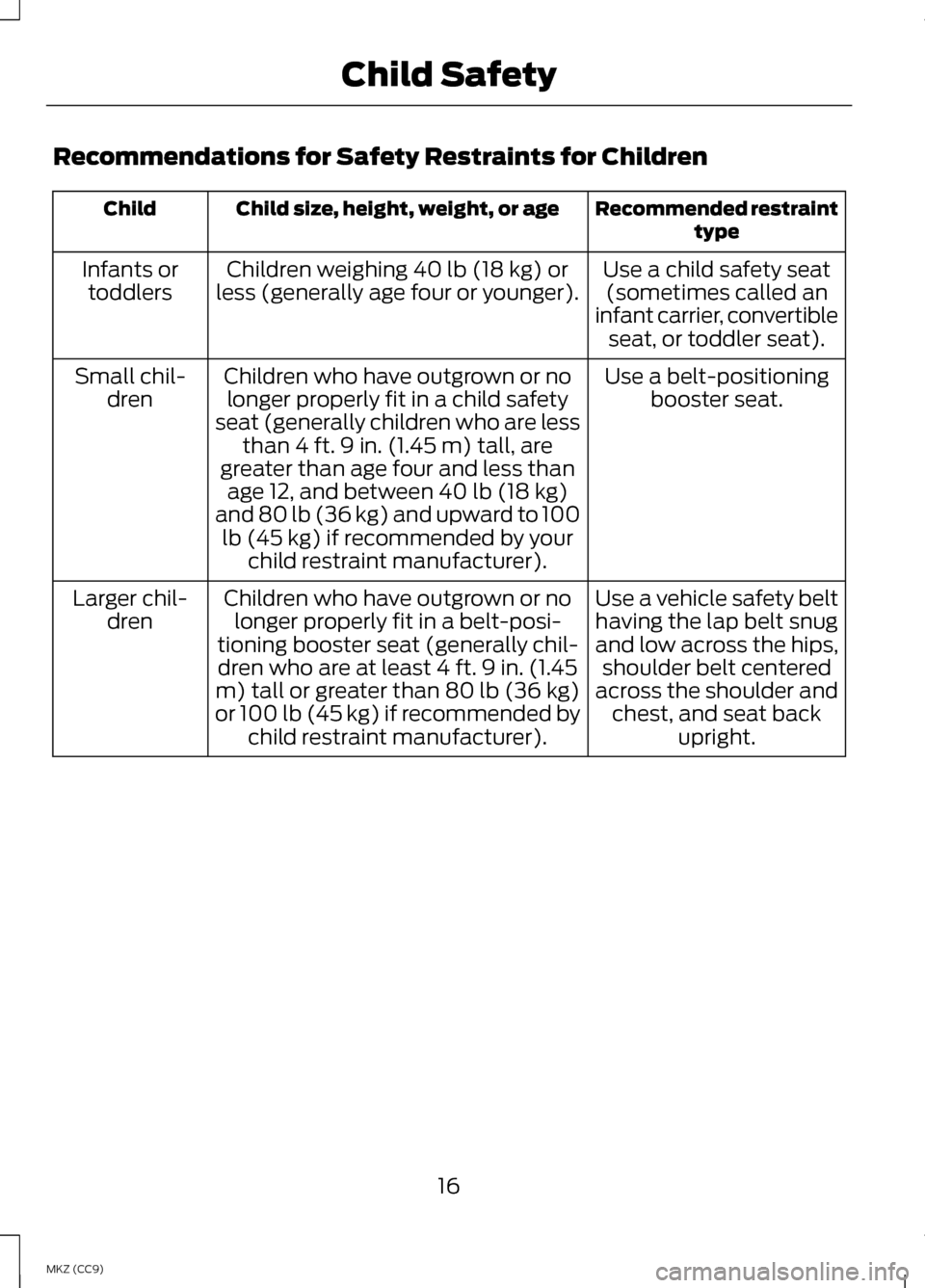
Recommendations for Safety Restraints for Children
Recommended restraint
type
Child size, height, weight, or age
Child
Use a child safety seat(sometimes called an
infant carrier, convertible seat, or toddler seat).
Children weighing 40 lb (18 kg) or
less (generally age four or younger).
Infants or
toddlers
Use a belt-positioningbooster seat.
Children who have outgrown or no
longer properly fit in a child safety
seat (generally children who are less than 4 ft. 9 in. (1.45 m) tall, are
greater than age four and less than age 12, and between 40 lb (18 kg)
and 80 lb (36 kg) and upward to 100 lb (45 kg) if recommended by your child restraint manufacturer).
Small chil-
dren
Use a vehicle safety belthaving the lap belt snug
and low across the hips, shoulder belt centered
across the shoulder and chest, and seat back upright.
Children who have outgrown or no
longer properly fit in a belt-posi-
tioning booster seat (generally chil- dren who are at least 4 ft. 9 in. (1.45
m) tall or greater than 80 lb (36 kg)
or 100 lb (45 kg) if recommended by child restraint manufacturer).
Larger chil-
dren
16
MKZ (CC9) Child Safety
Page 19 of 475
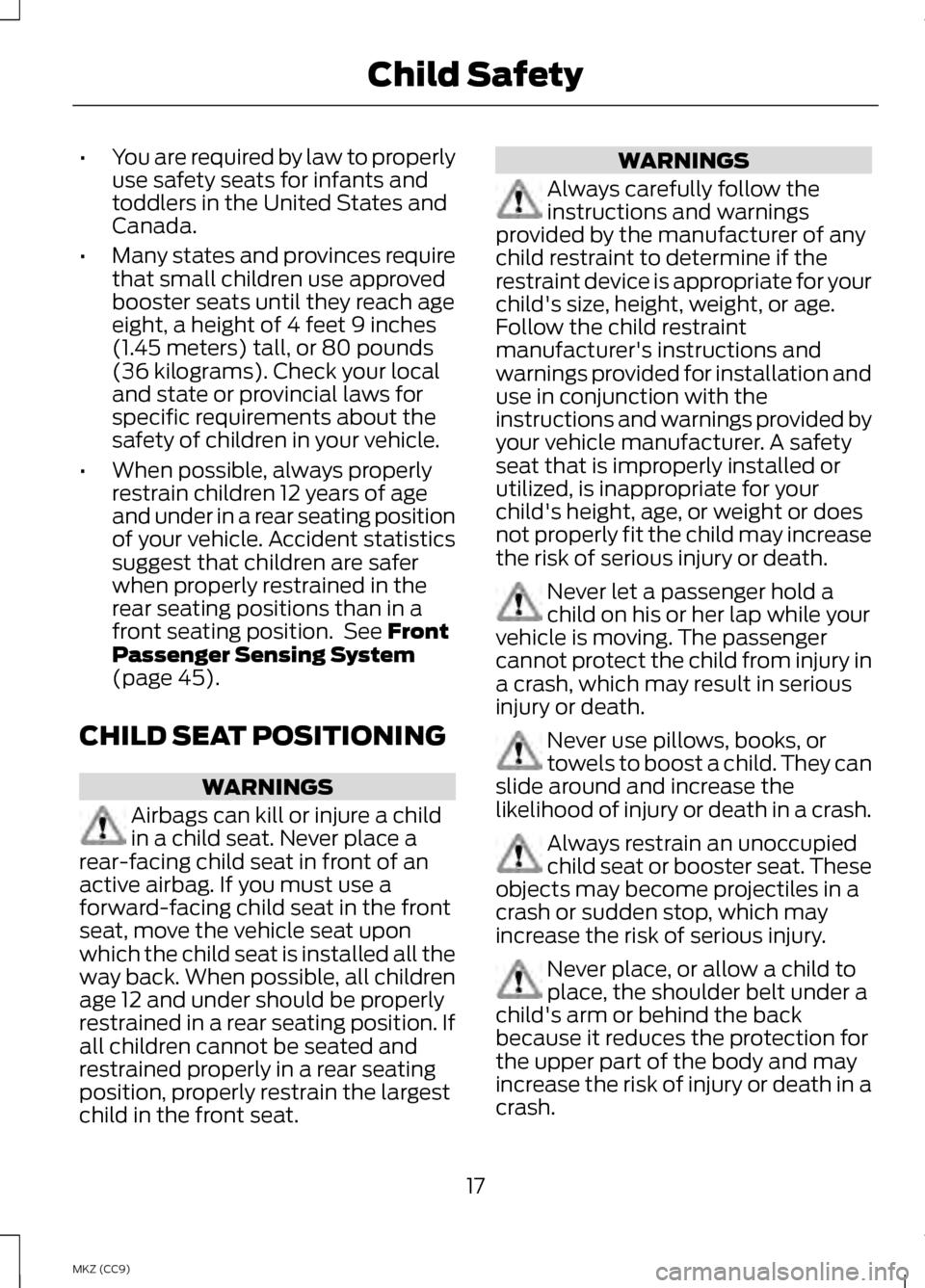
•
You are required by law to properly
use safety seats for infants and
toddlers in the United States and
Canada.
• Many states and provinces require
that small children use approved
booster seats until they reach age
eight, a height of 4 feet 9 inches
(1.45 meters) tall, or 80 pounds
(36 kilograms). Check your local
and state or provincial laws for
specific requirements about the
safety of children in your vehicle.
• When possible, always properly
restrain children 12 years of age
and under in a rear seating position
of your vehicle. Accident statistics
suggest that children are safer
when properly restrained in the
rear seating positions than in a
front seating position. See Front
Passenger Sensing System
(page
45).
CHILD SEAT POSITIONING WARNINGS
Airbags can kill or injure a child
in a child seat. Never place a
rear-facing child seat in front of an
active airbag. If you must use a
forward-facing child seat in the front
seat, move the vehicle seat upon
which the child seat is installed all the
way back. When possible, all children
age 12 and under should be properly
restrained in a rear seating position. If
all children cannot be seated and
restrained properly in a rear seating
position, properly restrain the largest
child in the front seat. WARNINGS
Always carefully follow the
instructions and warnings
provided by the manufacturer of any
child restraint to determine if the
restraint device is appropriate for your
child's size, height, weight, or age.
Follow the child restraint
manufacturer's instructions and
warnings provided for installation and
use in conjunction with the
instructions and warnings provided by
your vehicle manufacturer. A safety
seat that is improperly installed or
utilized, is inappropriate for your
child's height, age, or weight or does
not properly fit the child may increase
the risk of serious injury or death. Never let a passenger hold a
child on his or her lap while your
vehicle is moving. The passenger
cannot protect the child from injury in
a crash, which may result in serious
injury or death. Never use pillows, books, or
towels to boost a child. They can
slide around and increase the
likelihood of injury or death in a crash. Always restrain an unoccupied
child seat or booster seat. These
objects may become projectiles in a
crash or sudden stop, which may
increase the risk of serious injury. Never place, or allow a child to
place, the shoulder belt under a
child's arm or behind the back
because it reduces the protection for
the upper part of the body and may
increase the risk of injury or death in a
crash.
17
MKZ (CC9) Child Safety
Page 20 of 475
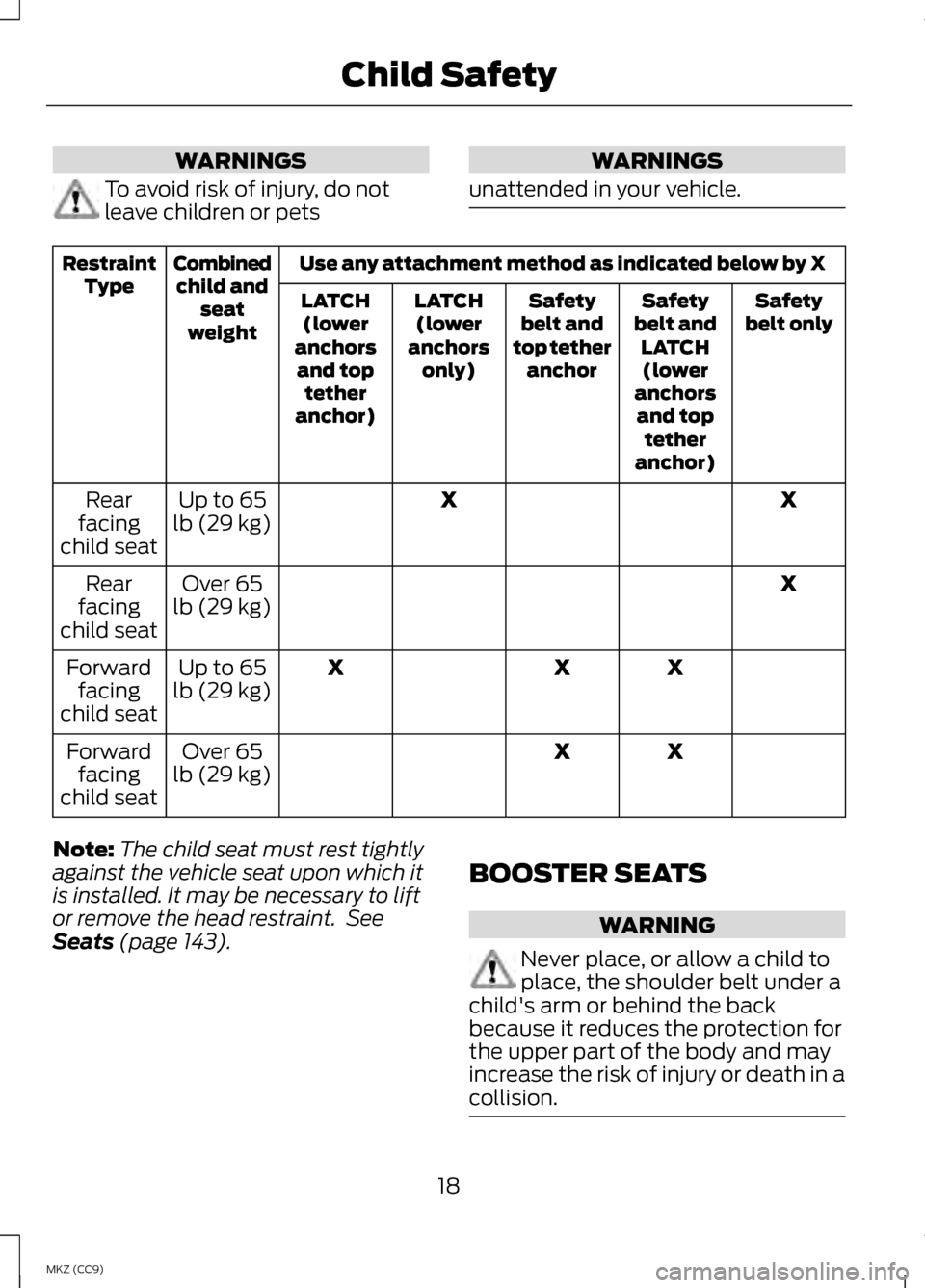
WARNINGS
To avoid risk of injury, do not
leave children or pets WARNINGS
unattended in your vehicle. Use any attachment method as indicated below by X
Combined
child and seat
weight
Restraint
Type Safety
belt only
Safety
belt and LATCH(lower
anchors and top tether
anchor)
Safety
belt and
top tether anchor
LATCH
(lower
anchors only)
LATCH
(lower
anchors and top tether
anchor)
X
X
Up to 65
lb (29 kg)
Rear
facing
child seat
X
Over 65
lb (29 kg)
Rear
facing
child seat
X
X
X
Up to 65
lb (29 kg)
Forward
facing
child seat
X
X
Over 65
lb (29 kg)
Forward
facing
child seat
Note: The child seat must rest tightly
against the vehicle seat upon which it
is installed. It may be necessary to lift
or remove the head restraint. See
Seats (page 143). BOOSTER SEATS WARNING
Never place, or allow a child to
place, the shoulder belt under a
child's arm or behind the back
because it reduces the protection for
the upper part of the body and may
increase the risk of injury or death in a
collision. 18
MKZ (CC9) Child Safety
Page 26 of 475
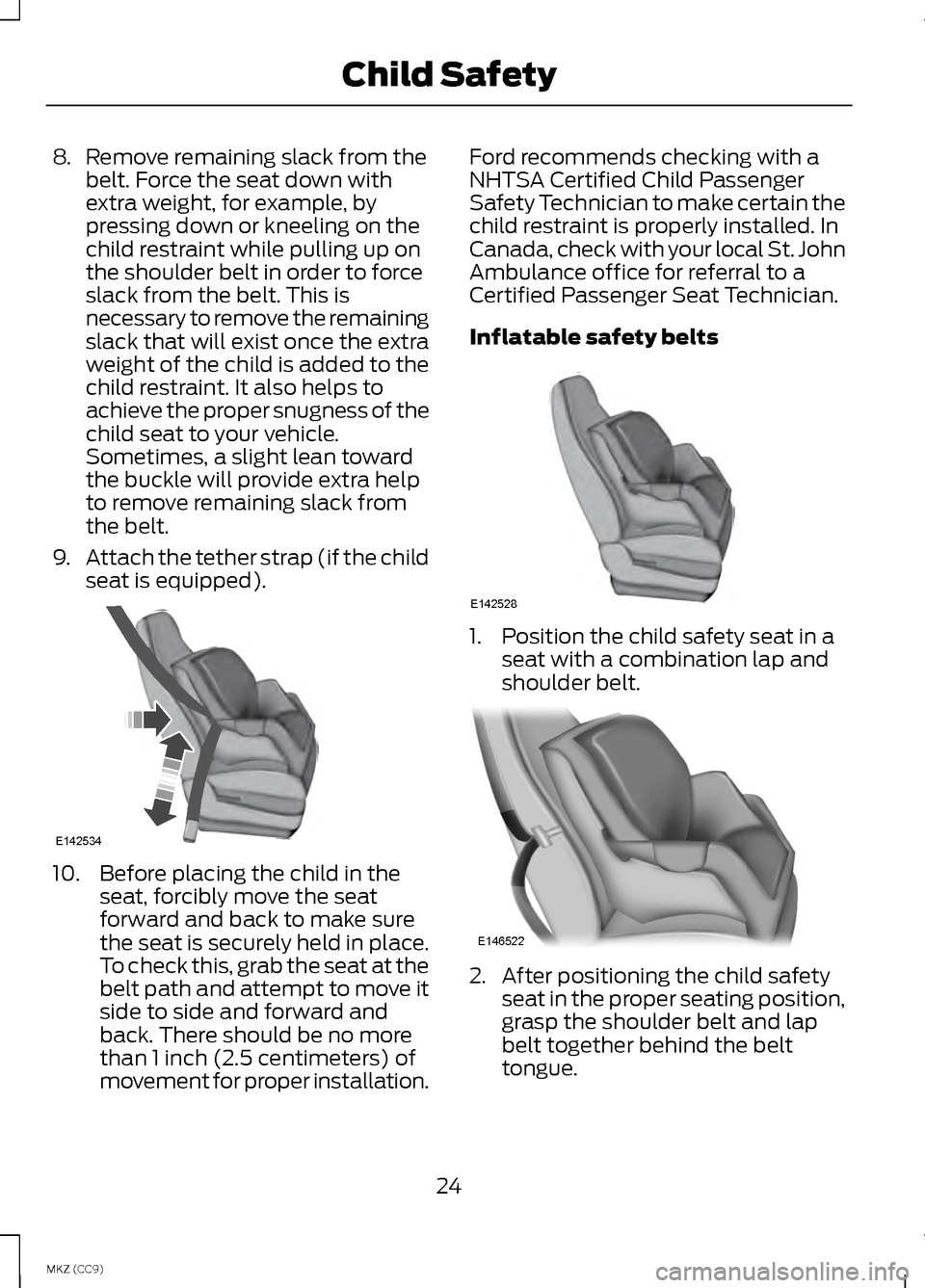
8.
Remove remaining slack from the
belt. Force the seat down with
extra weight, for example, by
pressing down or kneeling on the
child restraint while pulling up on
the shoulder belt in order to force
slack from the belt. This is
necessary to remove the remaining
slack that will exist once the extra
weight of the child is added to the
child restraint. It also helps to
achieve the proper snugness of the
child seat to your vehicle.
Sometimes, a slight lean toward
the buckle will provide extra help
to remove remaining slack from
the belt.
9. Attach the tether strap (if the child
seat is equipped). 10. Before placing the child in the
seat, forcibly move the seat
forward and back to make sure
the seat is securely held in place.
To check this, grab the seat at the
belt path and attempt to move it
side to side and forward and
back. There should be no more
than 1 inch (2.5 centimeters) of
movement for proper installation. Ford recommends checking with a
NHTSA Certified Child Passenger
Safety Technician to make certain the
child restraint is properly installed. In
Canada, check with your local St. John
Ambulance office for referral to a
Certified Passenger Seat Technician.
Inflatable safety belts
1. Position the child safety seat in a
seat with a combination lap and
shoulder belt. 2. After positioning the child safety
seat in the proper seating position,
grasp the shoulder belt and lap
belt together behind the belt
tongue.
24
MKZ (CC9) Child SafetyE142534 E142528 E146522
Page 28 of 475
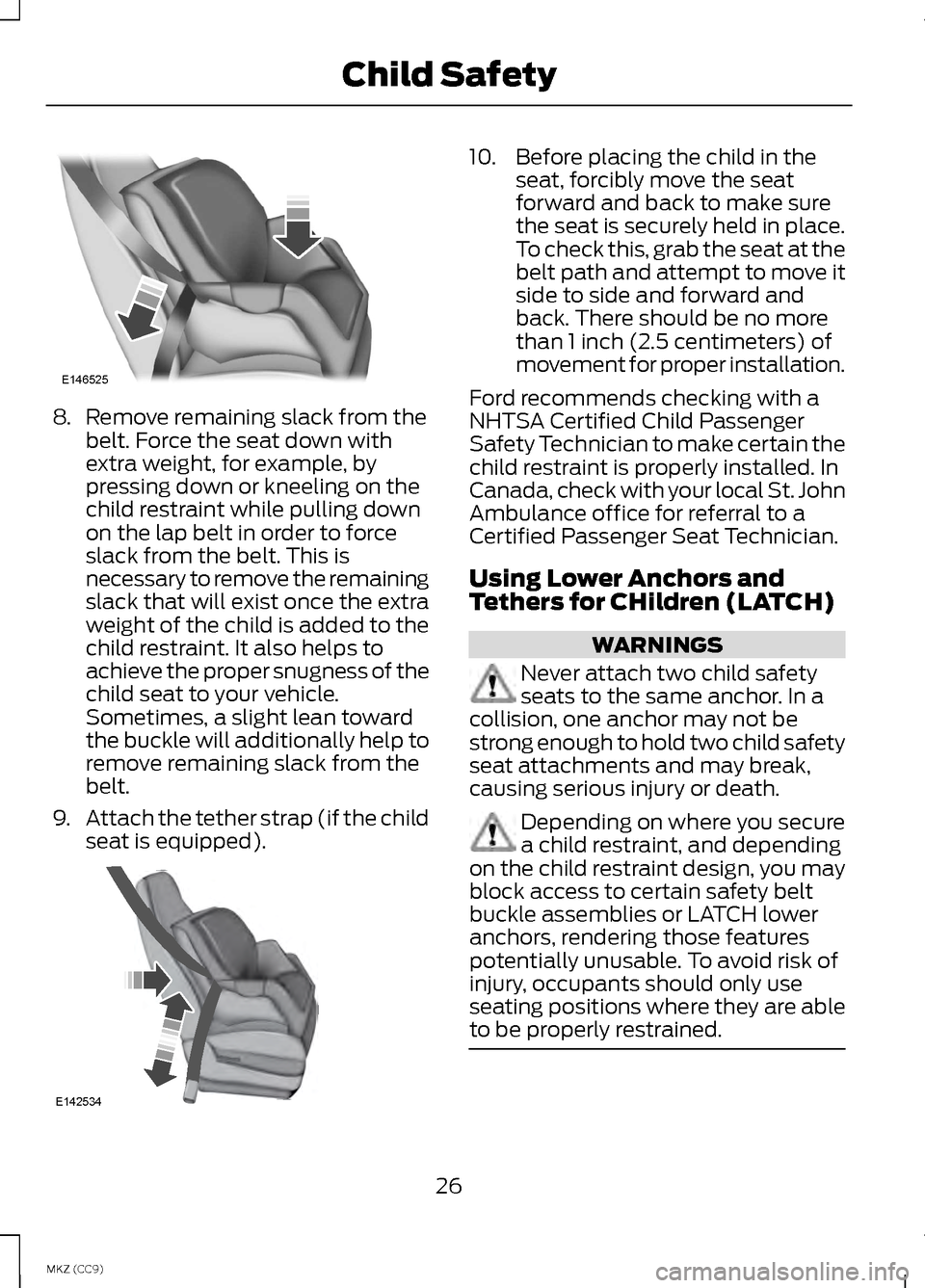
8.
Remove remaining slack from the
belt. Force the seat down with
extra weight, for example, by
pressing down or kneeling on the
child restraint while pulling down
on the lap belt in order to force
slack from the belt. This is
necessary to remove the remaining
slack that will exist once the extra
weight of the child is added to the
child restraint. It also helps to
achieve the proper snugness of the
child seat to your vehicle.
Sometimes, a slight lean toward
the buckle will additionally help to
remove remaining slack from the
belt.
9. Attach the tether strap (if the child
seat is equipped). 10. Before placing the child in the
seat, forcibly move the seat
forward and back to make sure
the seat is securely held in place.
To check this, grab the seat at the
belt path and attempt to move it
side to side and forward and
back. There should be no more
than 1 inch (2.5 centimeters) of
movement for proper installation.
Ford recommends checking with a
NHTSA Certified Child Passenger
Safety Technician to make certain the
child restraint is properly installed. In
Canada, check with your local St. John
Ambulance office for referral to a
Certified Passenger Seat Technician.
Using Lower Anchors and
Tethers for CHildren (LATCH) WARNINGS
Never attach two child safety
seats to the same anchor. In a
collision, one anchor may not be
strong enough to hold two child safety
seat attachments and may break,
causing serious injury or death. Depending on where you secure
a child restraint, and depending
on the child restraint design, you may
block access to certain safety belt
buckle assemblies or LATCH lower
anchors, rendering those features
potentially unusable. To avoid risk of
injury, occupants should only use
seating positions where they are able
to be properly restrained. 26
MKZ (CC9) Child SafetyE146525 E142534
Page 47 of 475
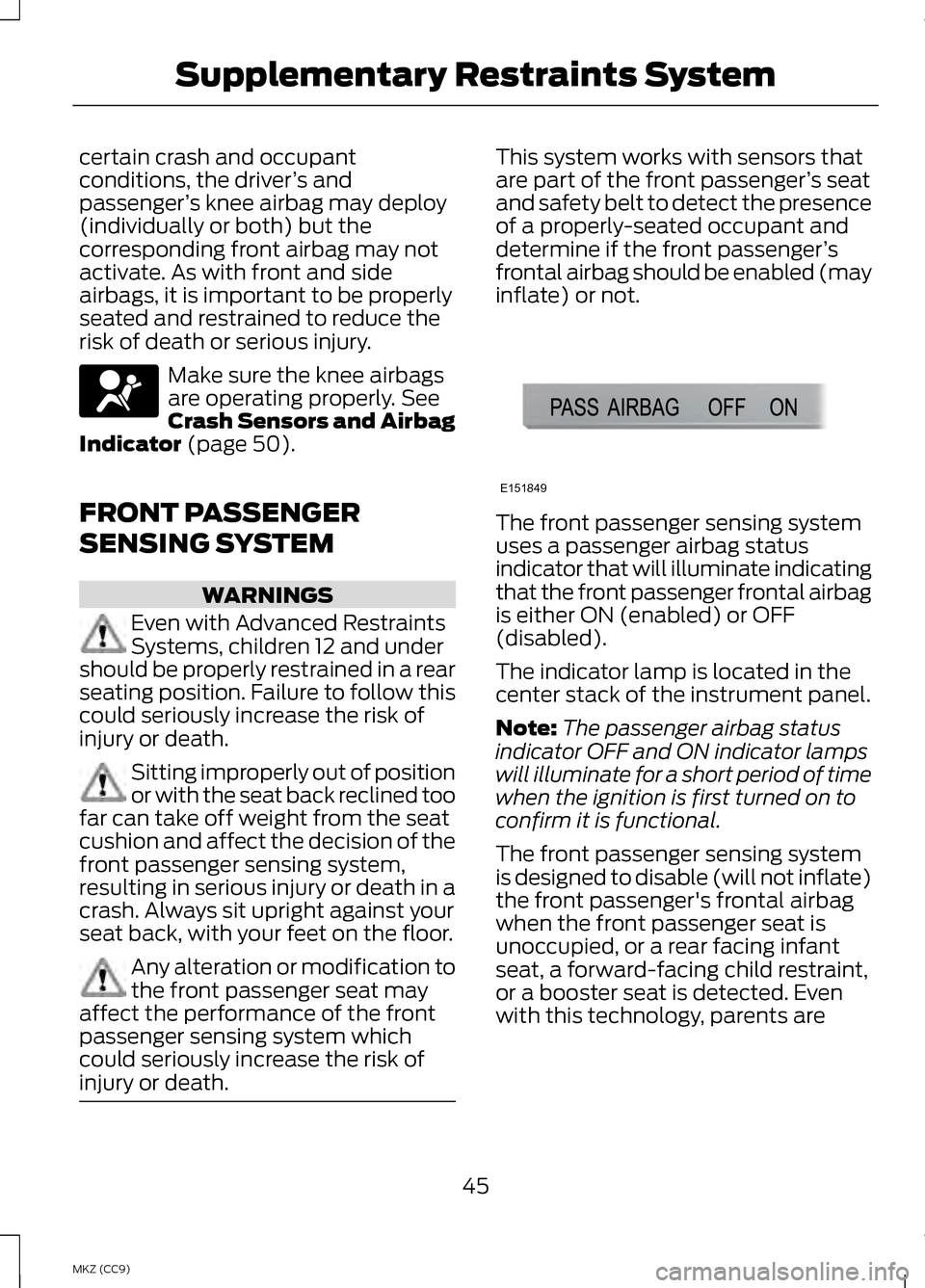
certain crash and occupant
conditions, the driver
’s and
passenger ’s knee airbag may deploy
(individually or both) but the
corresponding front airbag may not
activate. As with front and side
airbags, it is important to be properly
seated and restrained to reduce the
risk of death or serious injury. Make sure the knee airbags
are operating properly. See
Crash Sensors and Airbag
Indicator
(page 50).
FRONT PASSENGER
SENSING SYSTEM WARNINGS
Even with Advanced Restraints
Systems, children 12 and under
should be properly restrained in a rear
seating position. Failure to follow this
could seriously increase the risk of
injury or death. Sitting improperly out of position
or with the seat back reclined too
far can take off weight from the seat
cushion and affect the decision of the
front passenger sensing system,
resulting in serious injury or death in a
crash. Always sit upright against your
seat back, with your feet on the floor. Any alteration or modification to
the front passenger seat may
affect the performance of the front
passenger sensing system which
could seriously increase the risk of
injury or death. This system works with sensors that
are part of the front passenger
’s seat
and safety belt to detect the presence
of a properly-seated occupant and
determine if the front passenger ’s
frontal airbag should be enabled (may
inflate) or not. The front passenger sensing system
uses a passenger airbag status
indicator that will illuminate indicating
that the front passenger frontal airbag
is either ON (enabled) or OFF
(disabled).
The indicator lamp is located in the
center stack of the instrument panel.
Note:
The passenger airbag status
indicator OFF and ON indicator lamps
will illuminate for a short period of time
when the ignition is first turned on to
confirm it is functional.
The front passenger sensing system
is designed to disable (will not inflate)
the front passenger's frontal airbag
when the front passenger seat is
unoccupied, or a rear facing infant
seat, a forward-facing child restraint,
or a booster seat is detected. Even
with this technology, parents are
45
MKZ (CC9) Supplementary Restraints System E151849
Page 49 of 475
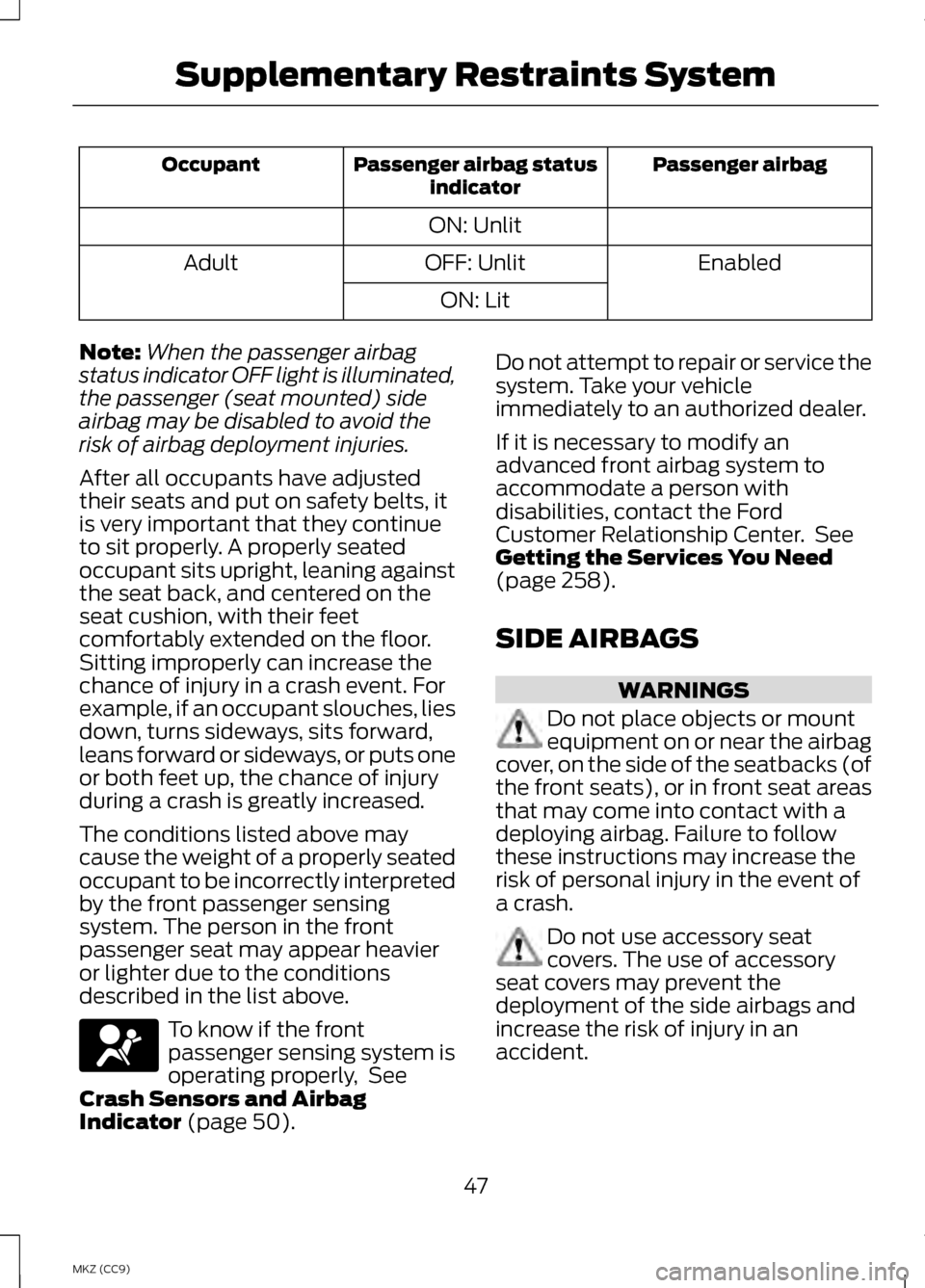
Passenger airbag
Passenger airbag status
indicator
Occupant
ON: Unlit Enabled
OFF: Unlit
Adult
ON: Lit
Note: When the passenger airbag
status indicator OFF light is illuminated,
the passenger (seat mounted) side
airbag may be disabled to avoid the
risk of airbag deployment injuries.
After all occupants have adjusted
their seats and put on safety belts, it
is very important that they continue
to sit properly. A properly seated
occupant sits upright, leaning against
the seat back, and centered on the
seat cushion, with their feet
comfortably extended on the floor.
Sitting improperly can increase the
chance of injury in a crash event. For
example, if an occupant slouches, lies
down, turns sideways, sits forward,
leans forward or sideways, or puts one
or both feet up, the chance of injury
during a crash is greatly increased.
The conditions listed above may
cause the weight of a properly seated
occupant to be incorrectly interpreted
by the front passenger sensing
system. The person in the front
passenger seat may appear heavier
or lighter due to the conditions
described in the list above. To know if the front
passenger sensing system is
operating properly, See
Crash Sensors and Airbag
Indicator (page 50). Do not attempt to repair or service the
system. Take your vehicle
immediately to an authorized dealer.
If it is necessary to modify an
advanced front airbag system to
accommodate a person with
disabilities, contact the Ford
Customer Relationship Center. See
Getting the Services You Need
(page
258).
SIDE AIRBAGS WARNINGS
Do not place objects or mount
equipment on or near the airbag
cover, on the side of the seatbacks (of
the front seats), or in front seat areas
that may come into contact with a
deploying airbag. Failure to follow
these instructions may increase the
risk of personal injury in the event of
a crash. Do not use accessory seat
covers. The use of accessory
seat covers may prevent the
deployment of the side airbags and
increase the risk of injury in an
accident.
47
MKZ (CC9) Supplementary Restraints System
Page 145 of 475
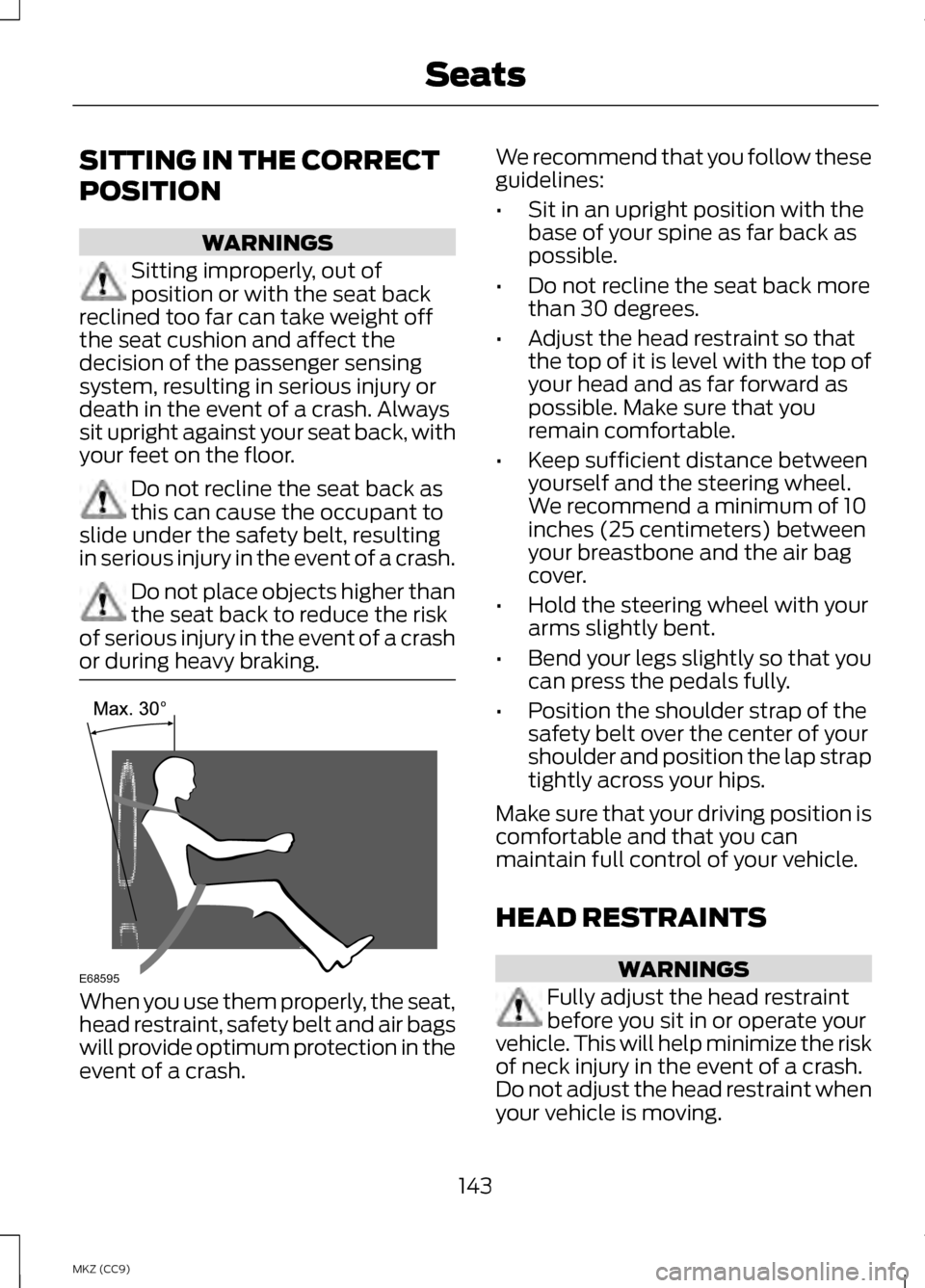
SITTING IN THE CORRECT
POSITION
WARNINGS
Sitting improperly, out of
position or with the seat back
reclined too far can take weight off
the seat cushion and affect the
decision of the passenger sensing
system, resulting in serious injury or
death in the event of a crash. Always
sit upright against your seat back, with
your feet on the floor. Do not recline the seat back as
this can cause the occupant to
slide under the safety belt, resulting
in serious injury in the event of a crash. Do not place objects higher than
the seat back to reduce the risk
of serious injury in the event of a crash
or during heavy braking. When you use them properly, the seat,
head restraint, safety belt and air bags
will provide optimum protection in the
event of a crash. We recommend that you follow these
guidelines:
•
Sit in an upright position with the
base of your spine as far back as
possible.
• Do not recline the seat back more
than 30 degrees.
• Adjust the head restraint so that
the top of it is level with the top of
your head and as far forward as
possible. Make sure that you
remain comfortable.
• Keep sufficient distance between
yourself and the steering wheel.
We recommend a minimum of 10
inches (25 centimeters) between
your breastbone and the air bag
cover.
• Hold the steering wheel with your
arms slightly bent.
• Bend your legs slightly so that you
can press the pedals fully.
• Position the shoulder strap of the
safety belt over the center of your
shoulder and position the lap strap
tightly across your hips.
Make sure that your driving position is
comfortable and that you can
maintain full control of your vehicle.
HEAD RESTRAINTS WARNINGS
Fully adjust the head restraint
before you sit in or operate your
vehicle. This will help minimize the risk
of neck injury in the event of a crash.
Do not adjust the head restraint when
your vehicle is moving.
143
MKZ (CC9) SeatsE68595
Page 154 of 475

Press the ventilated seat symbol to
cycle through the various cooling
settings and off. Cooler settings are
indicated by more indicator lights.
If the engine falls below 350 RPM
while the ventilated seats are on, the
feature will turn itself off and you will
need to reactivate it.
Heated and ventilated seat air
filter replacement (if
equipped)
Your vehicle is equipped with lifetime
air filters that are integrated with the
seats. Regular maintenance or
replacement is not needed.
REAR SEAT ARMREST
Fold the armrest down to use the
armrest and cupholder. To open the
storage lid, pull up on the latch
located between the cupholders.
Armrest pass-through
Note:
Do not exceed 80 pounds (36
kilograms) of weight on the
pass-through door. Release the latch, then pull down on
the door located in the back of the
armrest. You can store cargo of a
longer length such as skis or lumber.
152
MKZ (CC9) SeatsE144635 E152622